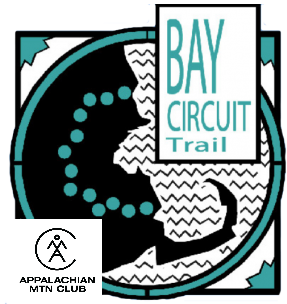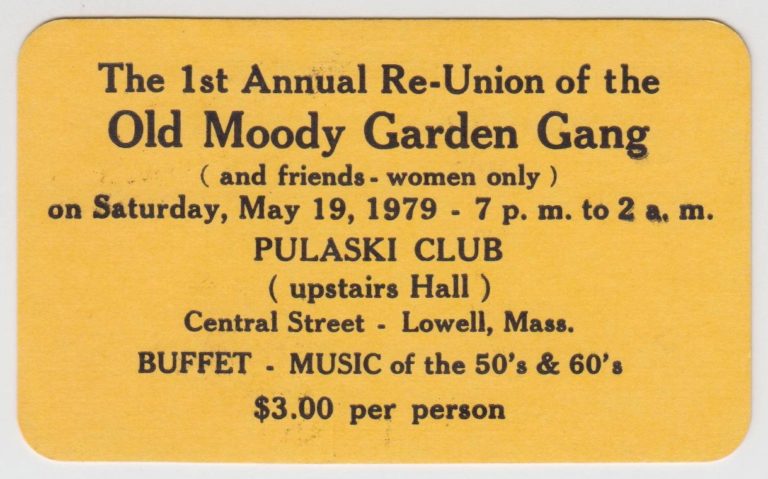Gifts from the Bay Circuit Trail
John Kenney aka Johnnie Flume
BCT End 2 Ender
December 2018
It felt oddly satisfying to toss my hiking boots in the trash barrel. They were gnarly, disfigured and leaky after 235 miles of walking across eastern Massachusetts. With my wife and friends. we had just completed the final segment of the Bay Circuit Trail. The Bay Farm path to the southern terminus was soggy with trail-spanning puddles from 24 hours of rain. Christmas had brought an REI gift certificate which would pay for new equipment. For two years, my Merrill boots had done their job, it was time for a new beginning.
My favorite memories from early days on the Trail were hikes over the tops of glacial eskers and along beaver dams. I hiked the Trail in 37 segments, each of 8 to ten miles, usually one day each week. The first dozen hikes led me to places far more remote than I expected. For the entire length of the E2E Trail, the sounds of airplanes overhead and faint commuter train horns were a constant reminder of the surrounding suburbs. But visually, the marshes, lakes, streams, hills and horse trails spoke of deeper woods and earlier times.
Recently retired, I often hiked alone on weekdays. Although never far from neighborhoods, roads and people, the trails were remarkably solitary. I often hiked for hours without encountering a single person. This provided plenty of opportunity to think about the history I was walking through. Each hike included reminders of the past: colonial patriot battle fields, ancient native habitats, mill ponds and spillways marking the earliest industrial days, and historic homes and deeds of the first European settlers.
I marveled at the hundreds of man-made foot bridges of every size and style along the Trail. Sometimes a single crude log spanned a small creek, other times a wooden walkway with handrails meandered out of view across a marsh. Each one was a reminder that fellow humans had expended time, money and resources to make my journey easier. People I had never met anticipated my needs and anonymously provided for me. My trek took place during the first two years of the Trump administration, a period which exposed alarmingly mean-spirited and selfish facets of human nature. I walked many worrisome miles thinking about the resurgence of nationalist evil and the destruction of social norms, but the bridges were a constant reminder that at the most basic level, humans are considerate of strangers.
One of most constant and frustrating lessons taught by the Trail was the art of navigation. Although it was often maddening, losing the Trail turned out to be an essential part of the experience. I’m proud to say that I was never “lost” in 37 day hikes. The GPS app on my phone always let me know precisely where I was. But many times, I “lost the trail.” Wrong turns and missing blazes added miles and hours to many segments.
As “losing the trail” became commonplace, I resolved to complete each upcoming segment without error. Before the hike I would review Dan Brielmann’s praiseworthy videosand plot the route in the ViewRanger GPS app on my phone. The plan for each hike took me from one parking spot to another, approximately eight miles distant. I could have walked farther, but I knew that the day’s walk could easily become 10 or more miles with a few wrong turns or missing blazes.
After a while, I kept a printed copy of the day’s trail guide in my pocket and used a pen to mark off each landmark to limit my backtracking. For a few hikes, I was so determined to avoid losing the trail that I set and reset a 20-minute alarm on my watch which reminded me to check GPS and confirm that I was still on the Trail. Oftentimes I would be one footstep from backtracking when a hint of a blaze appeared on a distant utility pole ahead. The lack of a blaze would cause increasing alarm, forcing the inevitable decision to continue or backtrack. As I crossed the boundary into each new town, I would be on high alert to see how diligently this new conservation committee cleared and blazed the Trail. Thankfully, most communities include civic associations and volunteers who are passionate about caring for their trails.
As I reached the final segments of the hike, I was amused to think that the white blazes had become a sort of sacred scripture to me. Like a Pilgrim, I was generally sure that my life and feet were headed in the right direction. But after a growing period of time without confirmation that I was on the Trail, uncertainty would creep in. The longer I went without reassurance, the wider the fissures in my faith became. Miraculously, the sight of a single white plastic marker erased all doubts. I would proceed energetically forward, knowing that mistrust would gnaw increasingly until I caught sight of the next blaze. I wondered about Life After the BCT. How will I navigate without the simple bedrock assurance of white blazes?
The BCT always seemed to provide exactly what I needed just as I needed it. I came to think of these as the Gifts of the Trail. Sometimes I wouldn’t realize that I was overdue to take a rest and eat. Just then, the Trail would offer up a bench or picnic table as a undeniable reminder. Other gifts included convenient parking spots, secluded woodland lavatories and the Dairy Queen one a sunny day in Ashland. At the end of December, the Trail conveniently passed by the Kingston Public Library just as we recognized the need to backtrack to warm up and take a quick bathroom break.
I learned to pay attention to whatever gifts the trail offered. With two segments to go on the Kingston route, I planned one long hike to get me within 4 miles of the southern terminus enabling a short celebratory finishing hike with friends. As I set out on the penultimate hike, I felt the confidence of a hiker with 230 miles of BCT experience who can learn nothing more from the Trail. But one final gift was in store.
I parked my truck next to a pristine cranberry bog at the southern end of the Hathaway Preserve. My Uber driver then deposited me eight miles up the trail where it passes the Country Corner Store in Pembroke. I was full of energy and self-assurance as I trekked through the Cranberry Watershed. A temporary lack of blazes led me astray for an 8-minute detour, which served to confirm my finely-tuned instincts for making timely navigational corrections.
Less than a half-mile from the end of my 7.9-mile plan, I entered Hathaway woodland on the lookout for “three consecutive bridges over Jones River.” Before I even had a clear view of the first bridge, I sensed something was amiss. The recent rains had flooded the whole area, and the wooden bridge had long ago collapsed into the rushing waters. Nearly within shouting distance of my truck, the Trail was absolutely impassable. I reluctantly considered my options: wade across, find a board or limb to put across the collapsed span, or find an alternate route.
The water was too deep, cold and swift to wade. There were no nearby materials long enough to steadily bridge the gap. The Jones River was swollen for the next hundred yards ahead, requiring multiple crossings with few obvious shallow connections. I resigned myself to backtrack and walk on roads the rest of the distance. I considered using Uber, since I had already walked more than seven miles, but that would result in a weirdly chopped-up final hike. The solution was a 2+ mile walk on the road, plus a short backtrack on the Trail to tag-up with the south side of the collapsed bridge. As I walked the extra distance, it occurred to me that the BCT had given me exactly what I needed at the exact moment when I needed it.
My parting gift from the BCT was a lesson in humility. No matter how thoroughly I researched and planned the segment, and despite my most diligent efforts to follow the blazes, something undesirable could occur at the most inopportune time. The Jones River detour granted me an extra hour on the BCT and the chance to laugh at the irony of expecting to be back at my truck exactly on schedule. The BCT provided a reminder to always be wary of arrogance brought on by impending success.
The Gifts of the Trail were many and constant. Quiet bridle paths, towering eskers, suburban mailboxed neighborhoods, lush wildlife sanctuaries, idle and rushing rivers sometimes constrained by dams, gritty city sidewalks, wide grassy meadows full of birdsong, noisy chainlinked highway crossings, cemeteries adorned with ancient granite and slate, buzzing power lines, helpful kiosks and bridges, and of course, the gift of another white blaze.
Ever seeking the next blaze,
Johnnie Flume

